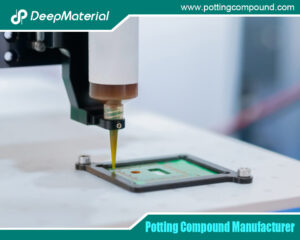

Electronics Potting & Encapsulation
No matter what the specific application or industry, protecting electronic components is crucial for ensuring long-lasting system durability and functionality. Available in various formats including encapsulates and gels, electronic potting compounds provide reliable protection for both complex and simple components in any type of environment.
Silicone encapsulates, in particular, contain no solvents or cure byproducts, allowing for lower costs. Providing optical clarity and thermal conductivity, they can perform in temperatures ranging from -45°C to 200°C. Silicone gels, on the other hand, provide ideal protection from moisture, as well as thermal and mechanical stress. They also protect against bubble or crack generation in high-voltage applications.
Some of the industry’s top manufacturers offer several types of electronic potting compound materials to help minimize stress and maximize reliability for flexible and rigid print circuit boards (PCBs), LED lighting and displays, industrial equipment, high-voltage electrical components, and power modules, among many other devices and systems.
Silicone encapsulates are available in two main types: condensation cure and addition cure, both of which can be supplied as one-part or two-part electronic potting compound systems to meet specific application needs.
One-part condensation cure silicones allow for ease of application and easy dispensing from a cartridge or tube, making these encapsulates ideal for thin-section cures of less than 7 millimeters. However, fixed cure speeds are required, and viscosity options are limited. Two-part condensation cure silicones, on the other hand, have a high tolerance to variations in the catalyst ratio and limited risk of inhibition. They do have slightly higher shrinkage levels than addition cures, however, as well as a reversion to liquid if heated in a container.
As with one-part condensation cure systems, one-part addition systems also allow for optimal ease of application. Featuring good physical strength, they can be used for both thin and thick section cures. However, they require heat to cure and have a short shelf life. Two-part addition cure systems allow for excellent deep section cures and low shrinkage rates. Their pot life can also be easily extended with an additive. Adequate adhesion is difficult to achieve with these two-part electronic potting compound systems, however, and they’re also prone to inhibition.
Two-Part Epoxy Compounds
Mix ratios are used for two-component epoxy systems to determine the amount of resin and epoxy catalyst needed for a full cure. The chemical makeup of the resin and the catalyst determine the mix ratios that must be followed; if not properly followed, various issues can occur, such as no cure or soft cure, as well as high exotherm during reaction, which can cause shrinkage.
Mix ratios are expressed by weight, volume, or PHR (parts per hundred). The ratio by weight and the ratio by volume are often different due to variations in density between resins and catalysts. Measurements by weight are more accurate, however, and are generally preferred over volumetric proportioning. When estimating the amount of mixed material, it’s important to know the pot life of the product in order to avoid wasting material.
DeepMaterial, a manufacturer of engineered materials and electronic potting compounds, has been proudly serving clients for over 10 years. Our expert staff specializes in a wide range of protective solutions for electronics, and we work closely with all our clients to ensure products are tailored to their unique needs.
To learn more about Dow’s electronic potting compounds and other adhesive products from manufacturers like Henkel, contact us or request a quote today.
Recent Posts
- The Comprehensive Guide to Polyurethane Potting Compound Manufacturers
- The Comprehensive Guide to Epoxy Potting Compound Manufacturers
- The Essential Guide to Potting Materials for Electronics
- The Expanding Horizon of the Mini Silicone Optical Glue Market
- The Comprehensive Guide to PCB Potting Services: Ensuring Reliability in Electronics
- Comprehensive Insights on PCB Encapsulation in Potting Material
- The Vital Role of Industrial Silicone Adhesive Manufacturers in Modern Industry
- The Potting Material Manufacturer: Essential Players in Electronics Protection
- Exploring the Role of Electronic Encapsulation in Potting Material Manufacturing
- The Growth of UV Cure Conformal Coating Market: Trends, Applications, and Future Outlook
Tags
Related Posts


The Comprehensive Guide to Epoxy Potting Compound Manufacturers

The Essential Guide to Potting Materials for Electronics

The Expanding Horizon of the Mini Silicone Optical Glue Market


